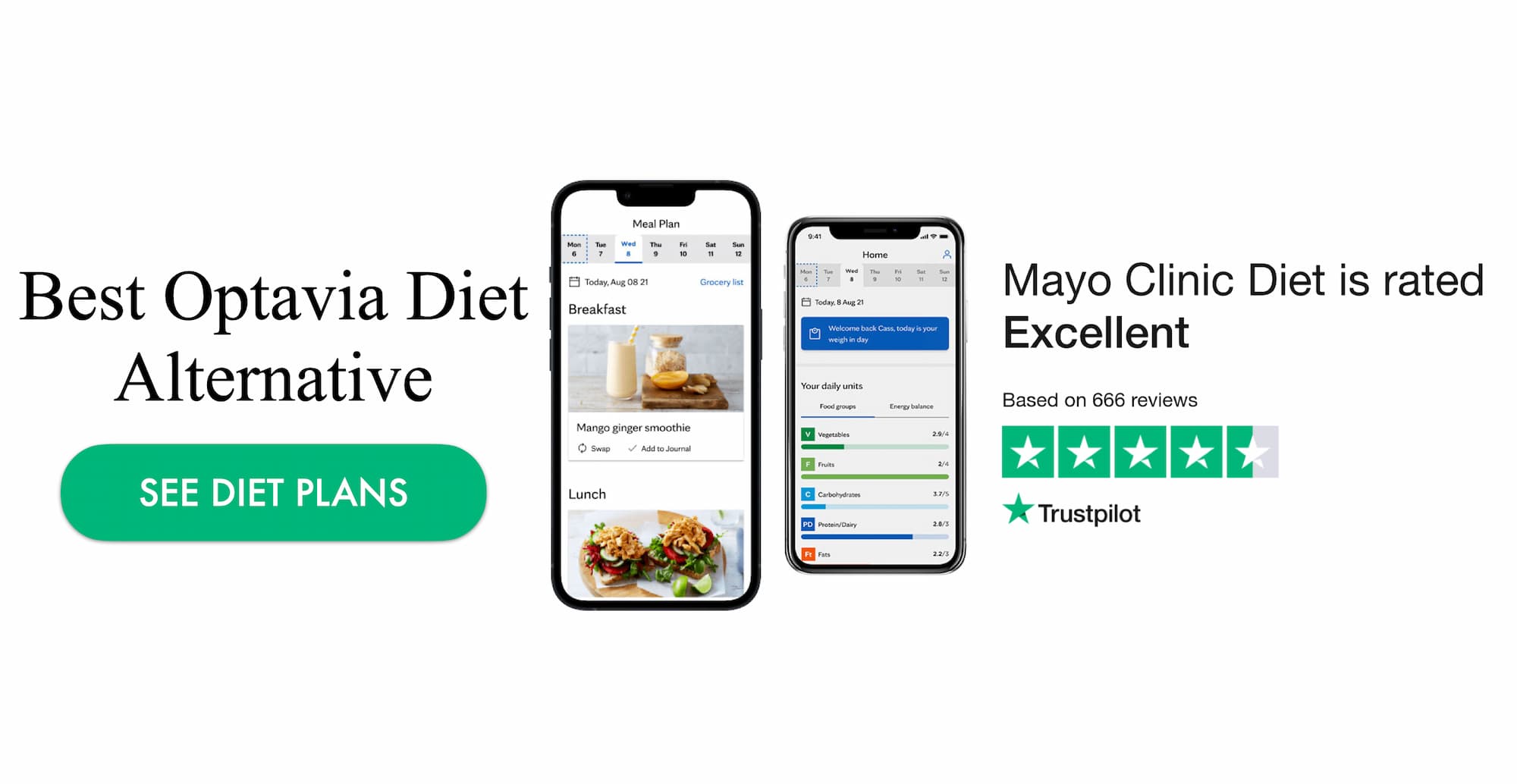Being “out of fat burn” on Optavia means your body’s switched from burning fat to using carbs or proteins. Eating too many carbs, going over your calorie limit, or straying from the Optavia plan can boot you out of the fat-burning zone.
It takes about 3-4 days of sticking to the Optavia plan to get back into fat burn. When you’re “in fat burn,” your body’s efficiently using stored fat for energy, which is what Optavia aims for.
As for what can kick you out of the fat-burning state on Optavia, there are 9 big culprits: eating too many calories, munching on off-plan foods, skimping on sleep, stressing out, over-exercising, not drinking enough water, boozing it up, skipping meals, and taking certain meds.
EatProteins.com is a reader-supported platform. Purchases made through our links may earn us a commission at no extra cost to you.
1. Consuming too many calories
Consuming too many calories on Optavia means you’re taking in more energy than you’re burning, disrupting the calorie deficit needed for fat loss. This factor typically occurs when you deviate from the Optavia meal plan, adding extra snacks or larger portions.
You’ll know it’s happening when you stop seeing progress in weight loss or body measurements, or even start gaining weight. If it happens, reassess your eating habits and get back on track with the Optavia meal plan, possibly consulting with a coach or nutritionist.
To prevent it, stick strictly to the Optavia meal plan and avoid adding extra calories through snacks or drinks. If you ignore it, you’ll likely stall your weight loss progress or even start gaining weight, negating the benefits of being in a fat-burning state.
2. Eating off-plan foods
Eating off-plan foods refers to consuming items that aren’t part of the structured Optavia diet, which can disrupt your fat-burning state. This factor occurs during social events, emotional eating episodes, or when you’re simply not prepared with Optavia-approved options.
You’ll know it’s happening when you experience symptoms like bloating, sugar cravings, or a sudden drop in energy levels, which are signs you’ve exited fat-burning mode. If it happens, don’t panic; just get back on track with your next Optavia-approved meal or fueling and maybe add some light exercise to help re-enter fat-burning mode.

To avoid it happening again, always have Optavia-approved snacks on hand, especially when you’re out and about or attending social events. Foods high in sugar and simple carbs will exacerbate the issue while sticking to Optavia-approved foods rich in protein and fiber can help alleviate it.
3. Lack of sleep
Lack of sleep is a factor that can disrupt the fat-burning process on the Optavia diet by affecting hormones like cortisol and insulin, which regulate metabolism. You’ll know it’s happening when you experience symptoms like increased hunger, irritability, and fatigue, despite following the Optavia diet.
This typically occurs when you’re consistently getting less than the recommended 7-9 hours of sleep per night. If it happens, prioritize sleep by setting a consistent bedtime and creating a calming pre-sleep routine.
If you ignore it, you risk not only stalling your fat loss but also increasing your chances of weight gain and other metabolic issues. For men, lack of sleep can lead to decreased testosterone levels, affecting muscle growth and fat loss; for women, it can disrupt menstrual cycles and hormone balance, affecting fat storage.
4. High-stress levels
High stress levels can disrupt the fat-burning process on Optavia by elevating cortisol, a hormone that encourages fat storage. This takes place usually during periods of emotional, physical, or mental stress, like work deadlines or family issues.
You’ll know it’s happening when you experience symptoms like irritability, difficulty sleeping, or even weight gain despite following the Optavia plan. To avoid it, incorporate regular stress-management practices into your routine, such as mindfulness, meditation, or yoga.
Foods high in sugar and caffeine can exacerbate stress, while foods rich in omega-3 fatty acids, like salmon, can help alleviate it. Men may experience increased abdominal fat, while women might find it more challenging to lose weight due to hormonal fluctuations exacerbated by stress.
5. Excessive exercise
Excessive exercise on Optavia refers to overtraining beyond the moderate exercise recommended, which can shift your body from fat-burning to a catabolic state. This happens when you’re pushing too hard in your workouts, often doing high-intensity training daily or multiple times a day.
You’ll know it’s happening when you experience symptoms like fatigue, irritability, and a plateau or even an increase in weight despite sticking to the Optavia plan. If it happens, the best course of action is to scale back on the exercise intensity and duration and focus on recovery.

If you ignore it, you risk not only stalling your weight loss but also increasing your chances of injury and hormonal imbalances. Men may experience a more significant drop in testosterone levels, while women might face disruptions in their menstrual cycle. To avoid it in the future, stick to moderate exercise as recommended in the Optavia guidelines, and make sure to include rest days in your routine.
6. Dehydration
Dehydration is a state where your body loses more fluids than it takes in, disrupting the metabolic processes crucial for fat burning on Optavia. This typically occurs when you’re not consuming enough water, especially during increased physical activity or hot weather.
Signs that you’re dehydrated include dark yellow urine, dry mouth, and fatigue, which can hinder your fat-burning progress on Optavia. If dehydration happens, immediately drink water or electrolyte-rich fluids to rehydrate and get your metabolism back on track.
To avoid dehydration, aim to drink at least 8 cups of water a day, more if you’re active, to support fat metabolism on Optavia. Ignoring dehydration can lead to severe metabolic imbalances, making it harder for your body to burn fat effectively. Foods high in sodium can exacerbate dehydration, while water-rich foods like cucumber and watermelon can help alleviate it.
7. Consuming alcohol
Consuming alcohol on Optavia can disrupt the fat-burning state by providing the body with an alternative, easily accessible source of energy. This usually happens when you indulge in alcoholic beverages, especially those high in sugar and carbs while following the Optavia diet.
You might notice a halt in weight loss progress, increased cravings, or even a hangover, signaling that you’re out of the fat-burning state. The simplest way to avoid this is by abstaining from alcohol or opting for low-carb, low-sugar options if you must drink.
If you find yourself out of the fat-burning state due to alcohol, it’s best to revert to the Optavia plan immediately and perhaps add some light exercise to help get back on track. Disregarding this factor could lead to weight gain, reduced diet efficacy, and potential health risks like liver damage over time.
8. Skipping meals
Skipping meals on Optavia disrupts the carefully planned Optavia Fueling schedule, potentially knocking you out of fat-burning mode. This usually happens when you miss one of the five small Optavia Fuelings that the Optavia plan recommends per day.
The best way to avoid it is to set reminders for your Optavia Fuelings and always have Optavia-approved snacks on hand to stick to the schedule. If you continue to skip meals it can lead to binge eating later, making it harder to get back into fat-burning mode.
Men might find it easier to return to fat-burning mode due to higher testosterone levels, while women may experience more prolonged disruptions.
9. Taking certain medications
Taking certain medications can interfere with your body’s ability to enter or maintain a fat-burning state while on the Optavia diet. This usually happens when you start a new medication or adjust the dosage of an existing one, especially those affecting metabolism or insulin levels.
You’ll know it’s happening if you experience a plateau in weight loss, increased cravings, or a sudden change in energy levels despite following the Optavia plan. If this happens, consult your healthcare provider to discuss medication alternatives or adjustments that won’t hinder your fat-burning state.
If you ignore it, you may find it increasingly difficult to lose weight or maintain muscle mass, and you might even gain weight. The impact of medications on fat-burning can vary between men and women due to hormonal differences, with women potentially experiencing more sensitivity to these medications.
What foods kick you out of the Fat Burn on the Optavia diet?
Foods that kick you out of fat burn on the Optavia diet are generally high-carb items that spike your insulin levels, inhibiting fat loss.
- Starchy Foods: Bread, pasta, rice
- Sugary Snacks: Cookies, candy, chocolate bars
- High-Sugar Fruits: Bananas, grapes, mangoes
- Sugary Beverages: Soda, fruit juice, energy drinks
- Processed Foods: Chips, crackers, pre-packaged meals
What Drinks Kick You Out Of Fat Burn On Optavia?
Consuming certain drinks, like soda, fruit juices, and energy drinks, can spike your insulin levels and inhibit fat loss. These sugary beverages are high in both sugar and calories, which can disrupt your fat-burning process on the Optavia diet.

What Alcohol Types Kick You Out Of Fat Burn On Optavia?
Types of alcohol on Optavia that can disrupt fat burn include beer, cocktails with sugary mixers, and sweet wines. Alcohol can slow down your metabolism and lead to fat storage, especially when consumed in excess. If you must drink while on Optavia, opt for spirits with zero-calorie mixers or dry wines in moderation.
How to get back into fat burn Optavia?
To get back into the fat burn on Optavia, you’ll need to strictly follow the program’s meal plan, avoid high-carb foods, and possibly increase your physical activity. Consistency is key; any deviation can prolong the time it takes to re-enter the fat-burning state.
How Long Does It Take to Re-enter Fat Burn on Optavia?
It typically takes about 3-5 days to re-enter fat burn on Optavia once you’ve been kicked out. This timeframe allows your body to deplete glycogen stores and switch back to fat as its primary fuel source.
What are the signs of fat burn on Optavia?
10 Signs of fat burn on Optavia include increased energy levels, reduced hunger, and possibly the presence of ketones in your urine or breath. These indicators suggest that your body has switched from burning carbs to burning fat for energy. Keep an eye out for these signs to know you’re on the right track.
Are There Any Supplements That Help Maintain Fat Burn on Optavia?
Yes, some people find that MCT oil or exogenous ketones can help. These supplements may boost ketone levels in the blood, potentially aiding in maintaining a fat-burning state. However, consult your healthcare provider before adding any supplements to your regimen.
